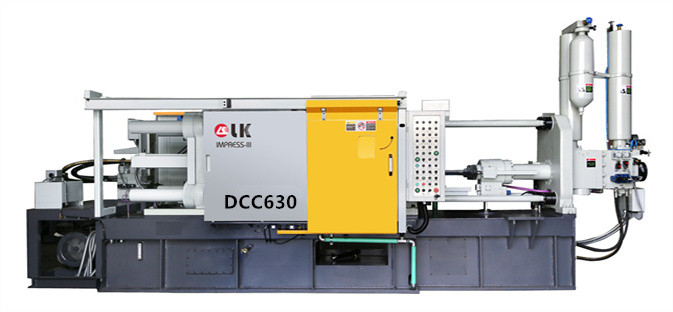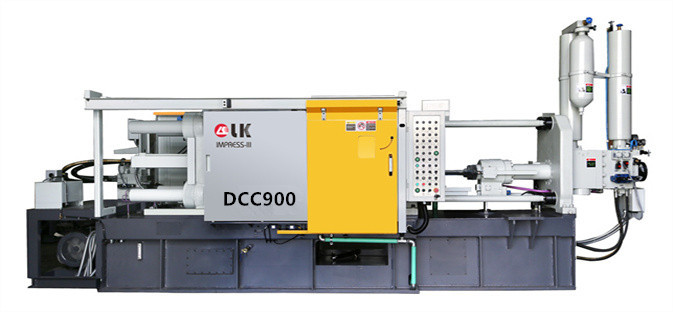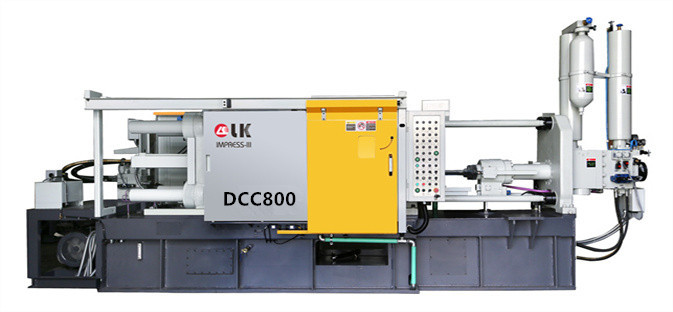Die Casting is Used to Manufacture Metal Parts and Structures
LK Die Casting Machine / 2024-07-05 14:16:13
Die casting is used to manufacture metal parts and structures
Die casting is an efficient and precise metal-forming process that is widely used to manufacture various metal parts and structures.
By injecting molten metal into a mold under high pressure, die casting can produce castings with complex shapes, precise dimensions, and smooth surfaces.
This process is not only suitable for mass production but also can significantly improve production efficiency and product quality.
This article will discuss the die-casting process and its application in the manufacture of metal parts and structures in detail.

Introduction to the Die Casting Process
Die casting is a metal casting process that forms molten metal by injecting it into a precision steel mold under high pressure. The die-casting process includes
the following steps:
1. Die design and manufacturing
The mold is the core of the die-casting process and determines the shape and quality of the casting.
The mold is usually made of high-strength steel with high wear resistance and thermal stability.
The mold design needs to consider the shape, size, material properties, and production process of the casting to ensure that the metal liquid can smoothly fill the mold and form a uniform casting.
2. Metal smelting
According to the material of the required casting, choose the appropriate metal or alloy for smelting. Common die-casting materials include aluminum alloy, zinc
alloy, magnesium alloy, and copper alloy.
The temperature and composition of the metal need to be strictly controlled during the smelting process to ensure that the molten metal has good fluidity and
molding properties.
3. Injection and molding
Injecting molten metal into the mold is a key step in the die-casting process.
The injection process is carried out under high pressure, and a die-casting machine is usually used to quickly inject the molten metal into the mold.
High-pressure injection can ensure that the metal liquid fills every corner of the mold and avoids casting defects such as pores, inclusions, and shrinkage.
4. Cooling and demolding
After the injection is completed, the casting is cooled and solidified in the mold.
The cooling time depends on the size and material of the casting, usually ranging from a few seconds to a few minutes.
After cooling is completed, the mold is opened, the casting is taken out, and necessary post-processing such as deburring, cleaning, and heat treatment is performed.
Advantages of die casting process
The die-casting process has many significant advantages, which makes it occupy an important position in the manufacture of metal parts and structures:
1. High production efficiency
The die-casting process can produce a large number of high-quality castings in a short time, which is suitable for large-scale industrial production.
The high degree of automation can significantly reduce labor costs and production cycles.
2. High precision and complex shapes
The die-casting process can produce castings with complex shapes and precise dimensions, meeting the needs of modern industry for high-precision parts.
The precision design and manufacture of the mold ensure the consistency of the shape and size of the casting.
3. Excellent surface quality
The surface of the die casting is smooth and almost no subsequent machining is required.
The high surface quality allows direct surface treatment such as painting and electroplating to improve the aesthetics and corrosion resistance of the product.
4. High material utilization rate
The material loss in the die-casting process is small, and the waste can be recycled and reused, reducing production costs.
A high material utilization rate helps to achieve sustainable development and reduce resource waste.

Application areas of die casting process
The die-casting process has a wide range of applications in the manufacture of various metal parts and structures, covering multiple industries such as
automobiles, aerospace, electronics, and home appliances.
1. Automobile industry
The die-casting process is widely used in the automotive industry to manufacture engine parts, gearbox housings, wheels, suspension system parts, etc.
Die-casting aluminum alloy and magnesium alloy parts are characterized by lightweight and high strength, which helps to improve the fuel economy
and safety of automobiles.
2. Aerospace
The aerospace field has extremely high requirements for parts and components.
The die-casting process can produce high-precision, high-strength, and lightweight aluminum alloy and titanium alloy parts for manufacturing aircraft
engines, fuselage structures, and avionics equipment.
3. Electronics industry
Electronic products have increasingly higher requirements for miniaturization and high precision of parts and components, and the die-casting process
can meet these requirements.
Aluminum alloy and zinc alloy die-castings are widely used in electronic products such as mobile phone cases, computer radiators, and connector shells.
4. Home appliance industry
Many parts of home appliances, such as washing machine drums, air conditioner compressor housings, and rice cooker liners, are manufactured by die--
casting.
The die-casting process can ensure the high precision and durability of these parts and meet the high-quality requirements of home appliances.

Development trend of the die-casting process
With the continuous advancement of technology, the die-casting process is also developing continuously, showing the following trends:
1. Automation and Intelligence
Modern die-casting technology is developing in the direction of automation and intelligence.
By introducing robots, sensors, and intelligent control systems, the production process can be fully automated and intelligently managed.
An intelligent die-casting process can improve production efficiency, reduce production costs, reduce human errors, and improve product quality.
2. Application of new materials
With the continuous research and development of new materials, the die-casting process is exploring more material applications, such as high-strength
aluminum alloys, magnesium alloys, and titanium alloys.
These new materials have better mechanical properties and corrosion resistance and can meet higher product performance requirements.
3. Environmental protection and sustainable development
The environmental protection and sustainable development of the die-casting process have also attracted much attention.
By optimizing process parameters, improving material utilization, and reducing waste and energy consumption, the die-casting process is developing in a
more environmentally friendly and sustainable direction.
4. Advances in mold technology
The advancement of mold technology is crucial to the development of die-casting process.
The application of new mold materials and manufacturing technologies makes the mold have a longer life, higher precision, and lower manufacturing
cost.
The continuous innovation of mold design and manufacturing provides strong technical support for the die-casting process.
Conclusion
As an efficient and precise metal forming process, die-casting has a wide range of applications in the manufacture of metal parts and structures.
By injecting molten metal into the mold under high pressure, die casting can produce castings with complex shapes, precise dimensions, and smooth
surfaces, meeting the needs of modern industry for high-quality parts.
With the continuous advancement and development of technology, the die-casting process is moving towards automation, intelligence, environmental
protection, and sustainability.
In the future, the die-casting process will continue to play an important role in promoting the development and progress of the manufacturing industry.
Contact LK Egypt to learn more info about the die-casting machine
LKAGENT OFFICE DCM
Address: Industry Zone, South of Port Said Kebly, Egypt
https://www.zazdiecasting.com/
Phone: +86 13598704163
Mobile: +20 101 304 3317 +20 150 181 8310
Email: jack@zazmae.com ahmedmahmoud@zazmae.com
#die cast tooling
#trivalent chromate
#rapid prototype casting
#a360 aluminum
#aluminum caster
#aluminum prototype
#ideal 55 slider parts
#density of aluminum kg/mm3
#magnesium sheet metal
#parts of a metal gate
#subcontracting of screw machining for the luxury sector
#wall aluminum
#die casting tooling
#tooling for die casting
#density of aluminium in kg mm3
#clear chromate
#es casting metals
#gating material
#prototype aluminum
#sigma castings
#subcontracting of screw-machining for household appliances
#we squeeze to please machine
#aluminium gravity die casting
#aluminum part
#aluminum rapid prototyping
#nickel casting
#plunger tip for die casting machine
#rapid prototyping aluminium
OTHER CONTENT
-

2024-09-19 14:16:15 LK Cold Chamber Die Casting Machine DCC900 Locking Force: 9000KN Die Height: 400-1000mm Space Between Tie Bars: 930x930mm Shot Weight: 13.5Kg Casting Area Max:2250c㎡
More -

2024-09-19 14:11:06 LK Cold Chamber Die Casting Machine DCC280 Locking Force: 2800KN Die Height: 250-650mm Space Between Tie Bars: 560x560mm Shot Weight: 2.9Kg Casting Area Max:700c㎡
More -

2024-09-19 10:23:07 LK Cold Chamber Die Casting Machine DCC580 Locking Force: 5000KN Die Heigh: 350-850mm Space Between Tie Bars: 760x760mm Shot Weight: 6.9Kg Casting Area Max:1250c㎡
More -

2024-09-19 10:11:20 LK Cold Chamber Die Casting Machine DCC400 Locking Force: 4000KN Die Height: 300-700mm Space Between Tie Bars: 669x669mm Shot Weight: 4.7Kg Casting Area Max:1000c㎡
More

